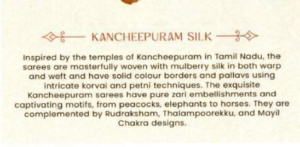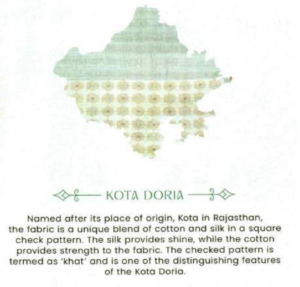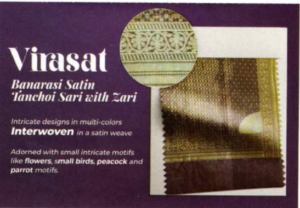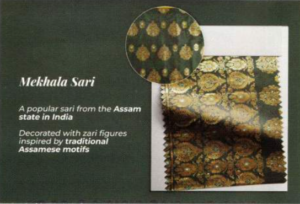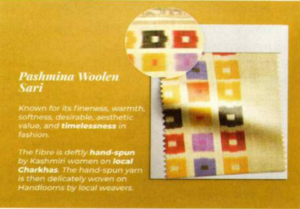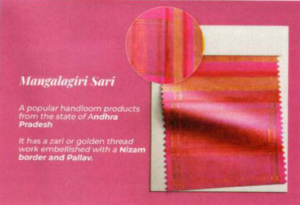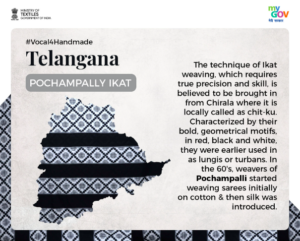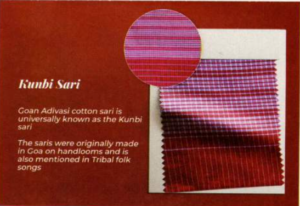Yojana Summary : May, 2024 – Weaves of India
1. VIBRANT WORLD OF WEAVES REGIONAL DIVERSITY IN INDIAN WEAVING
- 1. VIBRANT WORLD OF WEAVES REGIONAL DIVERSITY IN INDIAN WEAVING
- Introduction:
- 2. WEAVES OF INDIA – COLLABORATION AND CROSS-CULTURAL INFLUENCES
- 3. INDIAN WEAVES PROMOTING SUSTAINABILITY
- 4. UNRAVELLING THE RICH TAPESTRY: EXPLORING RARE WEAVES AND TEXTILES OF GUJARAT STATE
- 5. KHADI THE ICON OF INDIAN INDEPENDENCE
- 6. UNIQUENESS OF KHADI
- 7. HANDLOOM PRODUCTS OF INDIA: FROM LOCAL TO GLOBAL
- 8. WEAVING AS A LIVELIHOOD
Introduction:
- India’s weaving traditions are deeply rooted in regional cultures, showcasing a blend of mathematical competence and aesthetic finesse across villages, small towns, and cities.
- This article explores the diverse weaving techniques and cultural significance from various states.
A. Kerala
- Known for its ‘white’ culture and traditions, symbolising purity and austerity.
- Traditional weaving styles adapted with the introduction of chemical dyes in the late 19th century.
- Famous products include Mundu veshti and Kasavu saris from Balaramapuram.
B. Karnataka
- Centres like Molakalmuru and Ilkal thrive with unique weaving techniques.
- Specialises in yarn resist, patterned elements, and three shuttle weaving.
- Production of dupion silk and cotton-silk blends in various regions.
C. Maharashtra
- Known for cotton and silk weaving in regions like Vidarbha and Gadchiroli.
- Specialties include Nagpur and Puneri silk, Karvat Kathi, and Patal saris.
D. Goa
- Weaving legacy revived clandestinely during Portuguese rule.
- Known for intricate checks and unique colour combinations in saris.
E. Gujarat
- Produces a variety of weaves, prints, and Bandhani fabrics.
- Notable production centres in Surat, Ichalkaranji, Malegaon, and Bhiwandi.
F. Jammu and Kashmir, Ladakh, and Uttarakhand
- Specialises in wool spinning and weaving of Pashmina wool.
- Known for intricate khudrang patterns in shawls and apparel.
G. Rajasthan, Punjab & Haryana, Himachal Pradesh
- Rajasthan is known for hand-spun fabrics and printed textiles.
- Punjab and Haryana historically produced coarse fabrics for everyday wear.
- Himachal Pradesh is famous for Kullu and Kinnaur fabrics and shawls.
H. Uttar Pradesh
- Varanasi is renowned for intricate sari production using techniques like Kadhwa and Katarwa.
- Influenced by Persian weaving skills and Mughal craftsmanship.
I. Madhya Pradesh and Chhattisgarh
- Centres like Chanderi and Maheshwari are known for fine weaving techniques.
- Production of Tussar silk and cotton fabrics from Chhattisgarh.
J. Bihar
- Revival of tussar silk sarees from Bhagalpur known for self-patterned designs.
- Production of coarse cotton saris in tribal regions.
K. West Bengal
- Known for traditional sari weaves like mulberry silk and tussar.
- Adaptation to modern loom technologies while maintaining quality.
L. Odisha, Andhra Pradesh, and Tamil Nadu
- Odisha is renowned for patterned cottons and silk fabrics.
- Andhra Pradesh is famous for Venkatagiri, Uppada, and Gadwal silk-cotton sarees.
- Tamil Nadu is known for diverse sari designs inspired by nature and temple architecture.
M. North Eastern States
- Assam is known for Mekhela Chador and increasing sari production.
- Production of traditional apparel and weaving in Tripura, Mizoram, Meghalaya, Manipur, and Nagaland.
Conclusion:
- India’s weaving traditions highlight a blend of heritage and adaptation, showcasing ecological sustainability alongside skilled craftsmanship. Despite industrialization, these sectors maintain cultural authenticity and high artisanal value, positioning India as a leader in balancing traditional production with modern technology.
| Fabrics across India: |
|
Patan Patola: Double ikat silk saree from Gujarat known for vibrant colours, bold geometric designs, and meticulous craftsmanship.
Kota Doria: Rajasthan fabric blend of cotton and silk in a square check pattern (‘khat’), known for its strength and shine.
Paithani Sari: Silk sari from Maharashtra with intricate Zari pallav and borders featuring traditional motifs like vines, flowers, and birds.
Banarasi Satin Tanchoi Saree: Multi-colored satin weave saree from Banaras adorned with intricate floral and bird motifs.
Kanchi Cotton Sari: Traditional cotton saree from Kanchipuram District, Tamil Nadu, known for broad borders and traditional motifs. Mekhala Sari: Assam saree adorned with traditional zari figures and motifs.
Pashmina Woolen Sari: Fine, soft woollen saree from Kashmir spun by local women and handwoven by artisans.
Mangalagiri Sari: Andhra Pradesh handloom saree with zari work and Nizam border and pallav.
Paturu Cotton Silk Sari: Lightweight saree with plain Zari border and striped Pallav, typically from Andhra Pradesh. Pochampally Ikat: Traditional Telangana weave with geometric and abstract patterns created through resist dyeinAvailable in cotton and silk.
Gopalpur Tussar Silk Sari: Geographical Indication saree from Odisha with nature-inspired motifs like birds and wheels. Ikat Sari: Intricately patterned saree woven in double ikat style with dyed yarns. Kunbi Sari: Traditional Goan Adivasi cotton saree, hand loomed with cultural significance mentioned in tribal folk songs.
|
2. WEAVES OF INDIA – COLLABORATION AND CROSS-CULTURAL INFLUENCES
Introduction to Weaving in India
- Weaving in India is not just a craft but a sacred art, passed down through generations with divine guidance and pure dedication.
- Beyond its mythological origins, weaving is integral to the social and economic fabric of Indian communities, providing livelihoods and economic empowerment.
Evolutionary Journey of Indian Weaving
- Dating back to the Indus Valley Civilization (3300-1300 BCE), evidence shows advanced textile production and cotton cultivation.
- The Rigveda (1500-500 BCE) mentions weaving with religious and ceremonial significance.
- Influence of the Achaemenid Empire introduced Persian motifs and techniques.
- The Mughal Empire (1526-1857) further enriched Indian weaving with luxurious textiles like brocades and velvets.
- European traders introduced mechanised looms and synthetic dyes, transforming textile production in India.
Role of Royal Patronage
- Indian rulers supported weaving guilds and artisans, commissioning elaborate fabrics for ceremonies and festivals.
- This patronage fostered the production of intricate textiles adorned with traditional patterns and motifs.
Weaving as a Symbol of India’s Spirit
- Weaving transcends its functional roots, symbolising creativity, cultural transmission, and a cornerstone of daily life, beliefs, and rituals.
- It unites diverse cultural beliefs and preserves skills across generations.
Regional Weaving Traditions
- Banarasi Silk: Known for opulence and intricate patterns, reflecting ancient traditions and Mughal art.
- Paithani Weaving: Symbolises ‘Lakshya’ with intricate weaves, vibrant colours, and peacock motifs.
- Patola Craft: Represents ‘Vasudhaiva Kutumbakam’ through double ikat weaving and geometric patterns.
- Kanchipuram Silk: Embodies the concept of ‘Dharma’ with rich textures, vibrant colours, and distinctive zari borders.
Challenges and Way Forward
- Traditional weaving faces challenges like changing market demands, declining artisan numbers, and competition from mass-produced textiles.
- Collaborations with designers help preserve heritage, innovate designs, and secure livelihoods.
- Emphasis on ethical practices, fair wages, sustainability, and organic farming to reduce environmental impact.
Conclusion
- Traditional weaving techniques are safeguarded and celebrated to ensure their transmission to future generations.
- Global appreciation and partnerships with designers enhance the resilience and vibrancy of India’s weaving heritage.
3. INDIAN WEAVES PROMOTING SUSTAINABILITY
Indian Weaves: Eco-Friendly Tradition
- Indian weaves are known for their sustainability due to the use of natural fibers like cotton, silk, jute, and wool, sourced locally and processed with traditional techniques.
- These fibers are biodegradable, renewable, and support biodiversity, contrasting with synthetic alternatives that contribute to pollution and resource depletion.
- Traditional weaving practices provide livelihoods to millions of artisans, particularly in rural areas, supporting local communities economically.
Importance of Sustainable Fashion
- Investing in sustainable fashion that incorporates Indian weaves helps preserve these crafts and supports the welfare of artisans.
- The Cotton Corporation of India (CCI) plays a crucial role in promoting sustainability in cotton farming and weaving practices.
- CCI ensures Minimum Support Price operations for cotton, safeguarding farmers’ economic interests against market volatility.
CCI’s Role in Sustainability
- CCI’s efforts to promote Indian weaves contribute to global sustainability practices.
- It operates internationally in major cotton-producing countries and textile centers, enhancing India’s presence in the global textile market.
Challenges Facing Indian Weaves
- Competition from Mass-Produced Textiles: Traditional weaves face tough competition from cheaper, mass-produced textiles globally.
- Lack of Infrastructure: Many weaving communities lack essential infrastructure like reliable power supply and transportation, hindering productivity.
- Dwindling Interest Among Youth: There is a declining interest among younger generations in pursuing traditional weaving practices, posing a threat to artisan skills.
- Economic Viability Issues: Weaving communities struggle with low wages and inconsistent income, making it challenging to modernize their practices.
- Market Access Limitations: Limited access to domestic and international markets restricts the growth and profitability of Indian weaves.
- Sustainability Concerns: Environmental challenges such as water usage and chemical pollution necessitate eco-friendly production methods.
‘Kasturi Cotton Bharat’ Initiative
- The launch of ‘Kasturi Cotton Bharat’ aims to bring transparency to the cotton textile industry through blockchain technology.
- This initiative integrates traditional craftsmanship with luxury elements, enhancing the value of Indian cotton and promoting the country’s rich textile heritage.
Conclusion
- CCI’s initiatives offer hope amidst global environmental challenges by blending tradition with innovation and sustainability.
- By preserving India’s weaving heritage and supporting local artisans, CCI sets a precedent for a greener future.
- Partnerships and campaigns promoting sustainable Indian craftsmanship highlight the transformative potential of these initiatives.
4. UNRAVELLING THE RICH TAPESTRY: EXPLORING RARE WEAVES AND TEXTILES OF GUJARAT STATE
Bhujodi Weaving:
- Origin and Tradition: Bhujodi weaving originates from the village of Bhujodi in Gujarat, India, known for its vibrant handloom textiles.
- Craftsmanship: Artisans employ techniques like pit loom weaving and hand spinning, using locally sourced materials such as sheep wool and camel hair.
- Distinct Features: The textiles are characterised by vibrant colours, intricate patterns, and fine craftsmanship, preserving Gujarat’s rich textile heritage.
- Cultural Significance: Bhujodi weaving provides livelihoods to local artisans and contributes significantly to the cultural identity of the region.
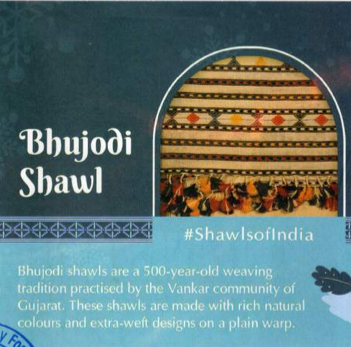
Ashavalli Sarees:
- Historical Background: Originating from Ashavalli town in Gujarat, these sarees trace their history back to the Mughal era, marked by royal patronage.
- Artisanal Mastery: Skilled artisans in Ahmedabad meticulously weave each saree by hand using fine silk or cotton yarns.
- Design Aesthetics: Ashavalli sarees feature intricate designs inspired by traditional motifs and patterns, often embellished with zari work or embroidery.
- Cultural Symbolism: Treasured for their beauty and cultural significance, these sarees symbolise grace and sophistication in Indian fashion.

Mashru Textiles:
- Innovative Blend: Mashru textiles are known for their unique blend of silk and cotton fibres, catering to both Hindu and Muslim communities in Gujarat.
- Historical Significance: The blend allows for luxurious silk on the outer surface and comfortable cotton on the inner side, reflecting cultural practices and preferences.
- Features: They are characterised by lustrous appearance, soft texture, vibrant colours, and intricate patterns.
- Continued Appreciation: Mashru fabrics continue to be celebrated for their craftsmanship and cultural importance in traditional attire such as sarees and turbans.
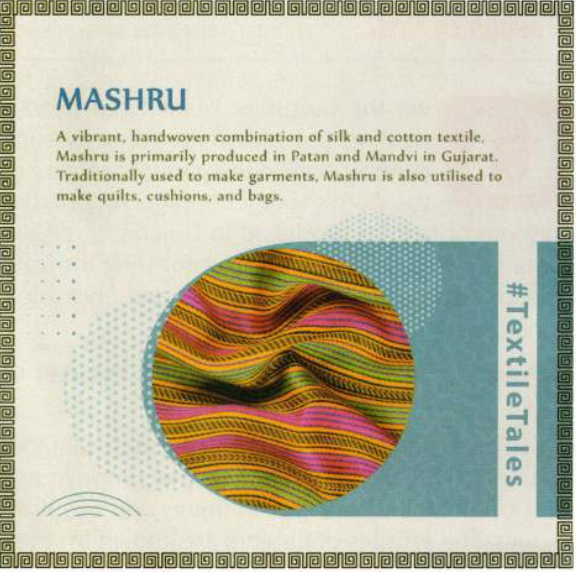
Patola Silk Sarees:
- Craftsmanship and Technique: Patola silk sarees are renowned for their double ikat weaving technique, where both warp and weft threads are dyed before weaving.
- Etymology: The name “Patola” originates from the Sanskrit term “Pattakulla,” highlighting the use of silk threads in weaving.
- Exquisite Details: Known for vibrant colours, intricate geometric patterns, and fine craftsmanship, these sarees were historically worn by aristocrats and royalty.
- Cultural Legacy: They are considered valuable heirlooms, passed down through generations and worn on special occasions like weddings and festivals.
- Modern Relevance: Patola silk sarees continue to be highly sought after, showcasing the enduring allure and cultural significance of traditional Indian textiles.
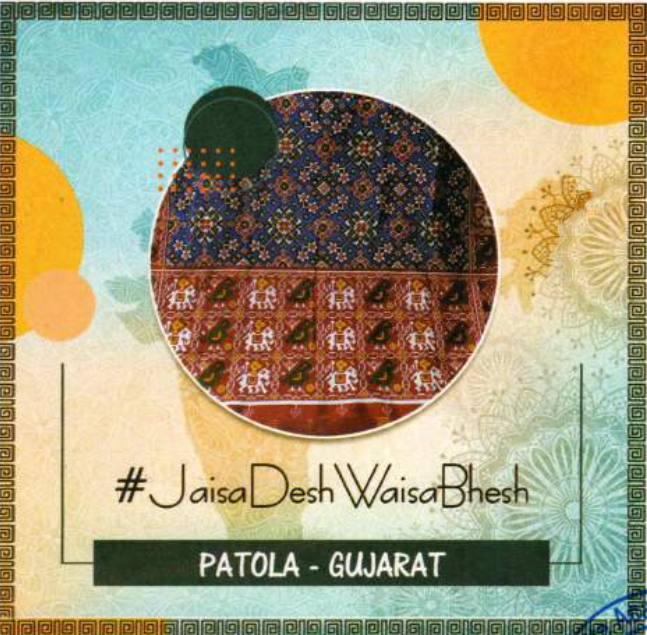
Conclusion:
- Gujarat’s textile heritage is a testament to centuries of craftsmanship and cultural exchange, with each weave reflecting intricate skills and historical significance.
- Bhujodi weaving, Ashavalli sarees, Mashru textiles, and Patola silk sarees exemplify the diversity and richness of Gujarat’s textile traditions.
- These textiles not only preserve cultural identities but also sustain livelihoods for local artisans, reinforcing their importance in India’s cultural and economic landscape.
5. KHADI THE ICON OF INDIAN INDEPENDENCE
Khadi Movement: A Symbol of Self-Reliance and Nationalism
Historical Context:
- Champaran Satyagraha: In 1917, Gandhi witnessed the hardships of Bihar farmers, highlighting their struggles with expensive cloth despite abundant indigo.
- Colonial Impact: British policies diverted Indian cotton to England, where it returned as costly Manchester cloth, crippling local textile industries and causing unemployment.
Traditional Textile Knowledge:
- Indian textiles, renowned for intricate designs, were prized globally, evidenced in ancient Egypt, Mohenjo-daro, and through Greek and Roman trade accounts.
- Impact of Colonialism: The Industrial Revolution and British policies devastated India’s textile sector, favouring cheap raw material exports and dominating local markets with British mill cloth.
Khadi Movement Origins:
- Spirit of Swadeshi: Gandhi emphasised Khadi as central to Swadeshi, essential for self-reliance and economic independence.
- Revival Efforts: Recognizing the importance of the spinning wheel, Gandhi promoted spinning and weaving as supplementary occupations, supported by Ahmedabad mill owners.
- Revitalising Traditional Methods: Gangabehn Majumdar led efforts to revive traditional spinning techniques, empowering villagers economically.
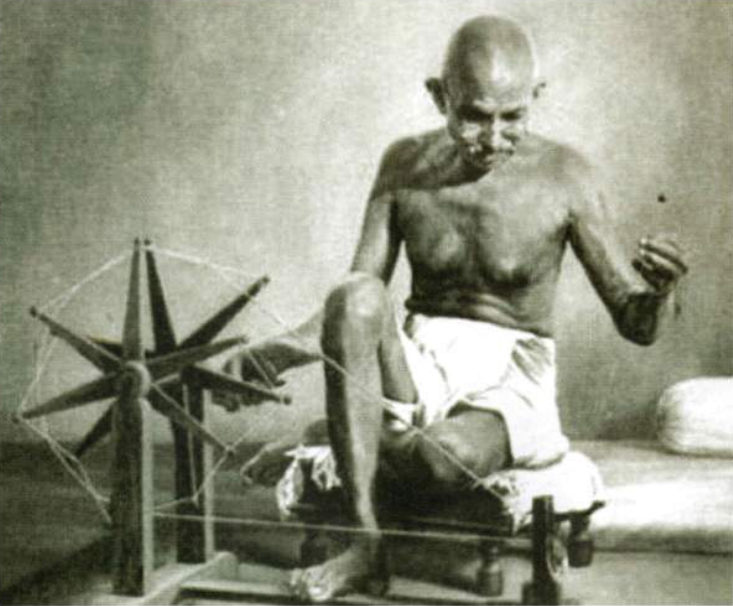
Khadi as a Symbol of Nationalism:
- Non-Violent Resistance: Gandhi used Khadi as a non-violent weapon against colonial exploitation, symbolising self-reliance and grassroots empowerment.
- Nationwide Movement: From Gandhi’s Ashram, Khadi spread as a symbol of nationalist pride, involving millions in its production and making it a cornerstone of the freedom struggle.
- Economic Impact: Khadi provided economic stability to rural India, particularly empowering women and promoting equitable income distribution through decentralised production.
Khadi Economics and Village Development:
- Empowerment through Self-Reliance: Khadi offered sustainable employment and wages to villagers, fostering economic stability until urbanisation provided alternative opportunities.
- Decentralised Production: Rajaji advocated for equitable wealth distribution through decentralised production, positioning Khadi as central to rural economies and supporting ancillary industries.
- Holistic Rural Development: Gandhi stressed the need to revive all village industries for comprehensive rural economic growth, ensuring effective utilisation of spare time and overall prosperity.
Icon of Independence:
- Political Symbolism: The Charkha and Khadi became iconic symbols of the independence movement, transforming an economic activity into a potent political statement.
- National Identity: Khadi embodied the spirit of nationalism, representing India’s struggle for freedom and economic self-sufficiency.
Conclusion:
- The Khadi Movement under Gandhi’s leadership transcended economics to become a cultural and political movement, empowering millions and asserting India’s identity and independence.
- Its legacy endures as a testament to grassroots empowerment, economic resilience, and the power of non-violent resistance against colonial exploitation.
- Khadi remains a symbol of India’s rich heritage and continues to promote sustainable development and equitable economic practices in rural communities.
6. UNIQUENESS OF KHADI
Khadi: Symbol of National Heritage and Freedom Movement
Definition and Historical Context:
- Khadi and Village Industries are integral to India’s cultural and economic fabric, embodying principles of self-reliance and sustainability.
- Definition: Khadi refers to any cloth woven on handlooms and hand-spun from cotton, wool, or silk yarn in India, or a combination thereof.
- Khadi emerged as a symbol of India’s freedom struggle, promoted by Mahatma Gandhi as a means of economic empowerment and resistance against British colonial exploitation.
Characteristics and Benefits:
- Natural Fibres: Khadi is predominantly made from natural fibres like cotton, silk, and wool, processed through hand-spinning and hand-weaving techniques.
- Softness and Comfort: Hand-spun and hand-woven Khadi fabrics are renowned for their softness, comfort, and breathability, making them ideal for Indian climatic conditions.
- Eco-friendly Dyes: Khadi fabrics are dyed using natural dyes such as indigo, alizarin, and extracts from plants like pomegranate and Myrobalan. These dyes are skin-friendly, eco-friendly, and contribute to the fabric’s comfort and sustainability.
- Sustainable Production: Khadi production supports rural economies by providing employment opportunities with minimal investment per capita. It promotes sustainable livelihoods and preserves traditional craftsmanship.
Unique Characteristics of Khadi:
- Zero Carbon Footprint: Due to its hand-made nature and use of natural fibres and dyes, Khadi is considered a zero carbon product, contributing positively to environmental sustainability.
- Organic Cotton: A significant portion of Khadi is now made from organic cotton, further enhancing its sustainability and appeal as an eco-friendly textile choice.
- Skin-friendly and Breathable: The natural properties of Khadi make it comfortable to wear, allowing the skin to breathe, and suitable for various climates across India.
Economic Impact and Reach:
- Mass Production: Despite its traditional roots in rural areas, Khadi production has scaled to meet demand from diverse segments of society, including affluent consumers.
- Economic Empowerment: Khadi production provides livelihoods to artisans and weavers in rural India, contributing to economic stability and community development.
- Cultural Significance: Beyond its economic impact, Khadi preserves India’s rich textile heritage and fosters pride in indigenous craftsmanship and sustainable practices.
Conclusion:
- Khadi remains a proud symbol of India’s independence struggle and Gandhian principles of self-reliance and sustainability.
- Its unique qualities, from natural fibre usage to eco-friendly production methods, underscore its relevance in the modern era of sustainable fashion.
- As a versatile fabric catering to diverse consumer segments, Khadi continues to promote economic inclusivity and environmental responsibility, ensuring its legacy as a cornerstone of Indian textile heritage.
7. HANDLOOM PRODUCTS OF INDIA: FROM LOCAL TO GLOBAL
Indian Handloom Sector: A Pillar of Employment and Cultural Heritage
Scale and Employment Impact:
- The handloom sector in India ranks second after agriculture in the unorganised sector, providing livelihoods to over 3 million people.
- It is the largest cottage industry in the country, with approximately 24 lakh looms dispersed across various regions.
Global Recognition and Market Reach:
- Indian handloom products are renowned worldwide for their uniqueness, quality, variety, and durability.
- Export Performance: Prior to the Covid-19 pandemic, Indian handloom exports maintained robust performance, consistently exceeding USD 300 million annually from 2016-17 to 2019-20.
- Impact of Covid-19: In 2020-21, exports faced a significant decline of 30% due to the pandemic’s onset.
- Recovery: There has been partial recovery in 2021-22, though exports have not yet reached pre-pandemic levels.
- Key Export Markets: Over 20 countries worldwide, particularly developed nations and the Middle East, demonstrate significant demand for Indian handloom products.
- US Dominance: The United States accounts for about 40% of international demand, highlighting its crucial role in Indian handloom exports.
- Middle East: Growing popularity in the Middle East underscores the products’ appeal across diverse cultural landscapes.
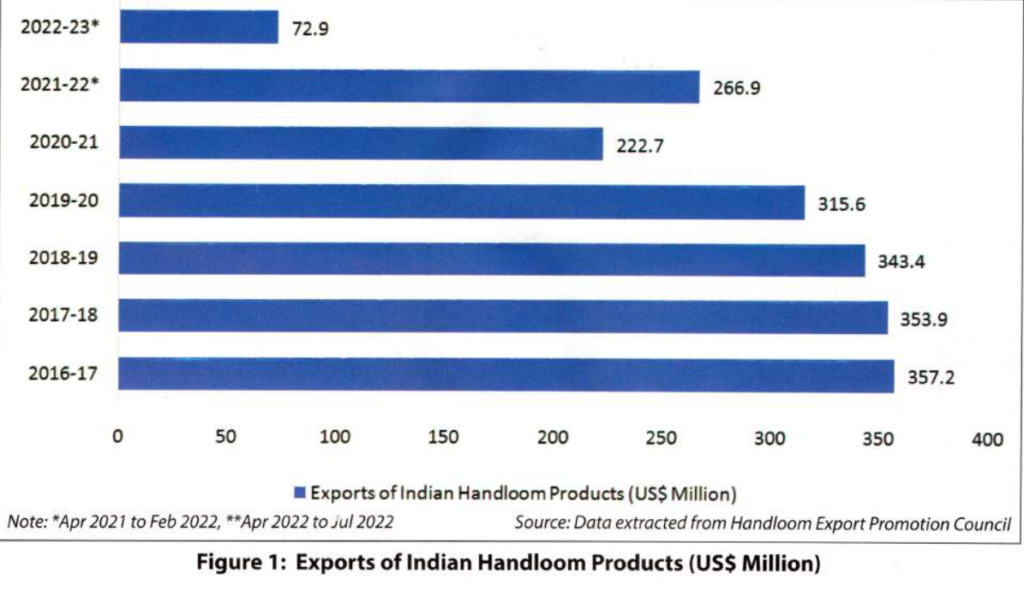
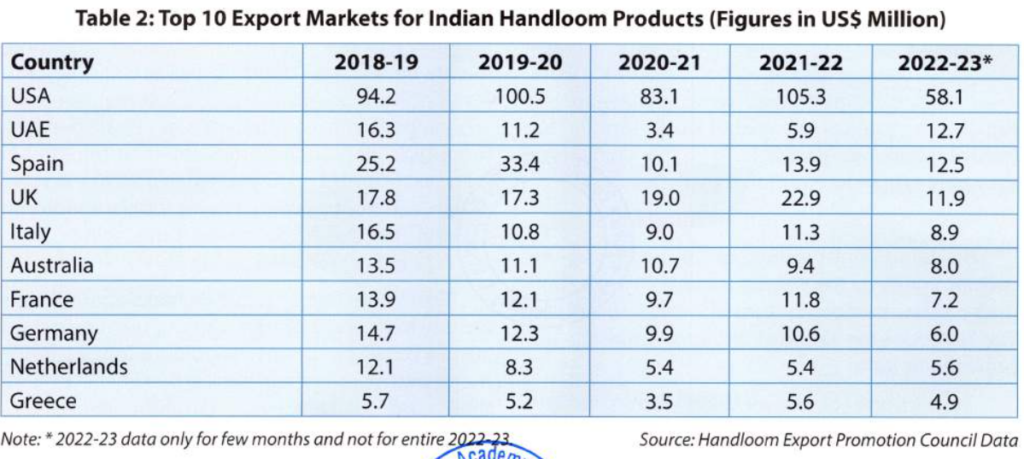
Factors Driving International Demand:
- Craftsmanship: Unique craftsmanship rooted in cultural heritage.
- Eco-friendliness: Use of natural fibres and dyes.
- Aesthetic Appeal: Designs that blend tradition with contemporary styles.
Product Composition and Export Segments:
- Product Mix: Home decor items like bed linen, curtains, table and kitchen linen constitute over 60% of exports. Mats and mattings make up around 30%.
- Mats, carpets, rugs, bedsheets, cushion covers, and other handloom articles are significant export items
Key Producing Cities:
- Cities like Karur, Panipat, Varanasi, and Kannur are prominent for producing a wide range of handloom products, including linens, textiles, and embroidered items.
- Quality Standards:Indian producers ensure high-quality products with minimal environmental impact and zero defects, fostering consumer trust.
Intellectual Property Rights (IPR) Protection:
- Legal Framework: Handloom products are protected under the Geographical Indications of Goods Act, 1999, and the Designs Act, 2000, ensuring IP protection both domestically and internationally.
Emerging Opportunities:
- Market Trends: Increasing preference for sustainable and environmentally friendly products among global consumers.
- Consumer Preferences: Demand from style-conscious yet environmentally conscious consumers supports the growth of handloom products.
Conclusion:
- Indian handloom products represent a blend of tradition and modernity, appealing globally due to their unique designs, quality, and environmental sustainability.
- These products have carved out a niche market in various countries, showcasing India’s rich cultural heritage and craftsmanship on the international stage.
8. WEAVING AS A LIVELIHOOD
Employment Potential:
- The handloom industry is estimated to be one of the largest sources of employment in India, second only to agriculture, providing livelihoods to over 3 million people.
Competition from Powerlooms:
- The sector faces stiff competition from cheaper, mass-produced products made by powerlooms, which are available in larger quantities.
Impact of Machine-made Goods:
- Many weavers are drawn towards machine-made goods due to their prevalence and ease of production, leading to a decline in traditional hand-weaving techniques.
Fashion and Design Challenges:
- Rapidly changing fashion trends and design preferences pose a challenge as few weavers have formal training in design and marketing, especially for urban markets.
Generational Shift:
- Due to economic pressures and limited opportunities, some weavers discourage their children from pursuing traditional weaving skills, opting for alternative career paths.
Ray of Hope for Handloom Weavers
Renewed Interest in Handmade and Sustainable Products:
- Growing global interest in handmade and sustainable products provides a new avenue of hope for handloom weavers.
- Hand-weaving processes produce no emissions and utilise natural raw materials, aligning well with eco-friendly consumer trends.
Collaboration with Fashion Designers and International Markets:
- Indian fashion designers are increasingly collaborating with rural weaving clusters, showcasing traditional handloom products in modern contexts.
- International fashion houses are also showing interest in Indian handicraft and handloom practices, providing global exposure and market opportunities.
Impact of E-commerce:
- The advent of e-commerce has revolutionised the market access for weavers, offering them a platform to reach new markets, access information, and enhance connectivity.
- Online platforms enable direct marketing of handloom products, bypassing traditional barriers and expanding customer reach.
Support from Organizations and Corporates:
- Some organisations and corporate entities are actively supporting weavers across the entire value chain, from providing raw materials to facilitating marketing and distribution.
Conclusion
Cultural Significance and Preservation:
- India’s rich tradition of handloom weaving reflects a cultural heritage that is unparalleled globally.
- The skill and knowledge of handloom weavers are invaluable assets that deserve recognition and support.
Call to Action:
- It is imperative for individuals and institutions to understand, support, and encourage the handloom sector to ensure its sustainability and growth.
- By promoting handloom products, we contribute to preserving a cultural legacy and empowering communities engaged in this traditional craft.

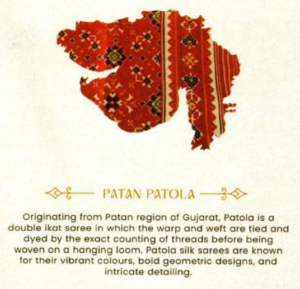 Kancheepuram Silk: Silk saree from Tamil Nadu with mulberry silk, solid colour borders, and intricate motifs like peacocks and elephants.
Kancheepuram Silk: Silk saree from Tamil Nadu with mulberry silk, solid colour borders, and intricate motifs like peacocks and elephants.